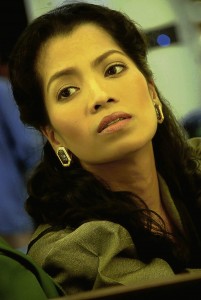Three more theater actors cast in ‘Bourne’
Filming for the Hollywood action caper “The Bourne Legacy” wraps up soon, and three more theater-trained Filipino actors – Bong Cabrera, Ruth Alferez and Kathlyn Castillo – have been cast in small roles.
For the trio, working in a big-budget international production is an affirmation.
Castillo recalls how last year, she and her peers were put in a bad light when a Cinemalaya indie fest participant said theater actors would work for crackers and cat food.
“We continue to fight off that impression,” Castillo says. “Hopefully our work in ‘Bourne’ would highlight our skills and lead to the improvement of our [image and] working conditions.”
Callback
Article continues after this advertisementCabrera, best actor in last year’s Cinema One fest (for Earl Bontuyan’s “Sa Ilalim ng Tulay”), agrees: “I am proud that most of the actors hired in ‘Bourne’ are theater people.”
Article continues after this advertisementCabrera is also hopeful that the recognition would improve their standing in the biz, “particularly, in terms of compensation. We are trained actors who can deliver anything that’s asked of us.”
Like veteran actors Joel Torre, Archi Adamos and Ermie Concepcion, the three didn’t bag the roles they auditioned for, but director Tony Gilroy asked them to report to the set.
Castillo recalls: “He wanted those who made it to the second callback to be included in key scenes so they’d have skilled actors.”
Alferez quips, “I was a ‘reactor’ in one scene. Tony said it was important to have professional actors do the reaction shots.”
Gilroy himself met with them to explain the scenes, they recount.
“He discussed our parts, emphasizing the importance of our scenes,” Alferez remembers.
Adamos describes Gilroy: “He was approachable and calm, though we were pressed for time (one-day shoot in a crowded factory). Jeremy Renner and Rachel Weisz were patient and methodical. We theater actors were there to support them in a huge scene with hundreds of extras.”
Cabrera was thrilled to join the “Bourne” team. “We seldom get big assignments like this,” he points out.
He had just returned from New York, where he took up acting lessons under an Asian Cultural Council grant. While there, he acted in James Camali’s short film, “I Die to Live.”
Cabrera and Alferez previously appeared in National Geographic documentaries.
Alferez enthuses: “It’s the closest I could get to Hollywood, at least for now. We weren’t allowed to bring cameras or cell phones to the set. But I took loads of mental snapshots.”
Castillo calls it a golden opportunity “to show the world how talented Filipino actors are and, at the same, learn from Hollywood techniques, especially since they brought in high-tech equipment.”
Cabrera concurs: “I was in awe of the state-of-the-art cameras and cranes.”
Even Adamos, a seasoned veteran, admits, “We learned new approaches to filmmaking.”
“I set out to observe a different system of working,” Castillo adds. In the end, she says, she realized that, “except for the high-tech equipment, they are just as efficient and as professional as Filipinos.”
Cabrera notes that one thing we can pick up is the “importance of pre-production. They spend a lot of time preparing. That’s why when it’s time to shoot, things run smoothly.”
Alferez agrees. “Everyone does their homework and comes prepared. So there’s no wasted time, unlike in local teleseryes.”
Castillo concedes that since Hollywood has a global market, “They’re not limited by time and budget constraints. We spend one whole day on one scene. In local shows, they churn out 20 to 60 sequences a day.”


